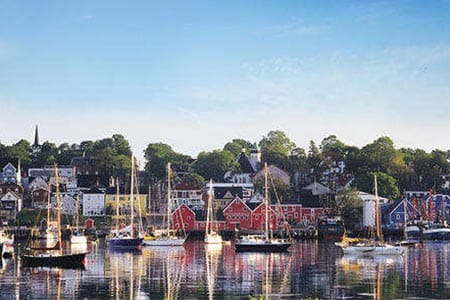The region's chefs embrace the Slow Food Movement.
Shortly after the intoxicating fiddlehead soup-served with pickled shiitake mushrooms and parsnip foam-comes the main course: an olive-oil-poached halibut steak crowned with sautéed, buttery-smooth goose-tongue greens. "Chris collected them himself this morning on the marsh," says Graziella Aerni, of her husband's side dish. Once common on the plates of families across the Maritimes, goose-tongue greens are a relatively unknown food these days. Now these greens are at the leading edge of an exciting revival of traditional foods.
Swiss-born chef Chris Aerni is taking local cuisine to a whole new level at his Rossmount Inn, just outside St. Andrews, NB. At the bottom of the menu, unceremoniously presented on a sheet of green, legal-sized paper is written: "Our menu honours the season's regional farmers, fishermen and producers."

The menu changes almost daily, according to what's in season and available. Not surprisingly, the oysters, lamb, salmon, halibut, lobster and beef, as well as lentils, herbs and greens like mizuna, lovage and arugula are sourced from local New Brunswick fishermen and organic farmers. But the Aernis go much further by offering locally grown handpicked fiddleheads, cattails, high-bush cranberries and mushrooms. Chris and Graziella even grow some of their own ingredients.
Across the Atlantic Provinces, chefs like Chris Aerni are reviving and reinventing local foods, combining them with exotic ingredients and preparing them in new ways. For instance, chef Ivan Kyutukchiev of Raymonds in St. John's earned a place at the 2009 Canadian Culinary Championships by winning gold at a regional competition. His dish was described by judge Karl Wells as a plate of caribou cloaked in a warm blanket of blueberry and port wine reduction; to one side, a circular coffee sponge was topped with a beet-blueberry parfait.
The culinary creations of chefs like Kyutukchiev and Aerni are part of a global trend toward favouring local foods, best exemplified by the Slow Food Movement. In fact, Kyutukchiev started a convivium, or chapter, of the worldwide organization in St. John's. Michael Howell leads one of three Nova Scotia chapters from the Tempest Restaurant in Wolfville; on PEI, Robert Shapiro at Dayboat Restaurant has started one.
Carlo Petrini of Bra, Italy, founded the Slow Food Movement in 1986 to promote local, organic food, and to encourage sustainable agriculture, preserve culinary history and foster links between food producers and consumers. With the snail as its symbol, the Slow Food Movement and its 100,000 members in 153 countries has raced to international prominence.
Chef Roland Glauser of Charlotte Lane Café in Shelburne-named the best small restaurant by the Restaurant Associa-tion of Nova Scotia in 2010-makes regular trips to Italy, where the movement started. Glauser features lots of local seafood on his menu, and the longstanding star remains Lobster and Scallops Brandy Gratin-a suitable slow food dish for a county that claims to be the lobster capital of the world.
The Wolfville chapter is particularly busy organizing events such as Incredible Picnics and the Slow Motion Film Food Festival. Three years ago, Howell teamed up with Hazel Dill, then principal of Dr. Arthur Hines Elementary School in neighbouring Hants County, to help the students plant a vegetable garden. A 20-minute film called The Edible Schoolyard came out of that project.
Diners at any of the region's slow food restaurants can experience food that is both delicious and responsibly produced.



